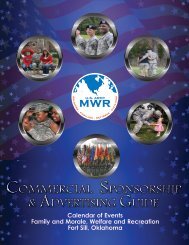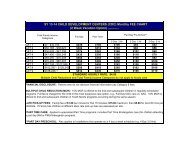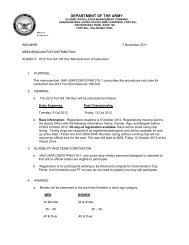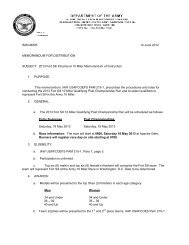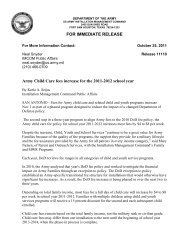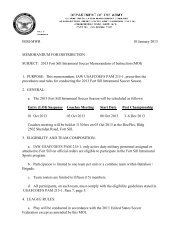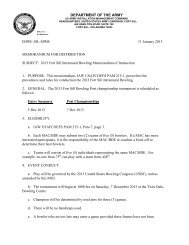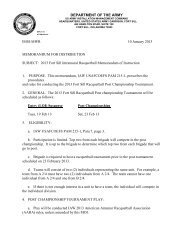Preparing and Managing Correspondence - Fort Sill MWR
Preparing and Managing Correspondence - Fort Sill MWR
Preparing and Managing Correspondence - Fort Sill MWR
Create successful ePaper yourself
Turn your PDF publications into a flip-book with our unique Google optimized e-Paper software.
example follows:<br />
BY ORDER OF THE SECRETARY OF THE ARMY: Used by the US Total Army Personnel Comm<strong>and</strong> on military<br />
personnel matters only.<br />
h. Deputy Chief of Staff. When signing for the DEPUTY CHIEF OF STAFF, make sure authority has been granted.<br />
See AR 10–5, Organizations <strong>and</strong> Functions, Headquarters, Department of the Army.<br />
Section II<br />
Signatures <strong>and</strong> Signature Blocks<br />
6–3. Signatures<br />
a. Use the regulation or directive governing the action involved to decide on the appropriate signature. If signature<br />
is not prescribed, write the signature as desired, which normally includes the full name. The individual may use an<br />
initial or initials in place of first <strong>and</strong> middle names. The typed name will match the signature. Once individuals decide<br />
on their official signature, they should use the same signatures for official actions throughout their employment or<br />
services with DA.<br />
b. A signature is the name of the individual written by h<strong>and</strong>. (See para 6–10 for the use of facsimile signatures.)<br />
c. If the person whose name is typed does not sign personally, the individual authorized to sign will sign his or her<br />
own name <strong>and</strong> add the word for in front of the typed name in the signature block. If an individual in the military signs<br />
for another, the signer should show his or her rank following the signature. If a civilian signs for an individual in the<br />
military, include his or her title (for example, Mr., Mrs., or Ms.).<br />
d. On THRU correspondence, when no comment is made, the signer will line through the appropriate address <strong>and</strong><br />
initial <strong>and</strong> date the line out.<br />
6–4. Signature block<br />
a. General. The signature block will include—<br />
(1) The name of the person who signs the military correspondence. Type, stamp, or print it in capital letters identical<br />
to the individual’s signature, except as shown in (3) <strong>and</strong> (4) below.<br />
(2) Rank, branch, <strong>and</strong> title of military official or title of civilian official except as shown in (3) below.<br />
(3) “Comm<strong>and</strong>ing” for comm<strong>and</strong>ers to denote the active exercise of authority.<br />
(4) Do not use abbreviations or titles designating religious <strong>and</strong> fraternal orders or academic <strong>and</strong> honorary degrees in<br />
signature blocks on official correspondence unless their use will either benefit or improve the image of the Army. See<br />
paragraphs 2–3i(3) <strong>and</strong> 2–3i(4).<br />
(5) “Comm<strong>and</strong>er’s Signature” is required by Federal statute on certain forms. All other forms will have “Authorized<br />
Signature,” “Signature of Approving Authority,” “Signature of Reviewing Authority,” or other phrases as appropriate.<br />
The requiring document will state who is specifically authorized to sign as Authorized Signature <strong>and</strong> how to obtain<br />
authentication.<br />
(6) Civilians will use only a two-line signature block consisting of name <strong>and</strong> title, unless a third line is necessary for<br />
a long title. Civilians should not use “DAC” (Department of the Army Civilian) on a signature block unless the civilian<br />
is attached to or serving with a multiple-Service organization.<br />
b. Placement. Begin the signature block at the center of the page on the fifth line below the authority line. If there is<br />
no authority line, begin it on the fifth line below the last line of the text.<br />
c. Omission. If the identity of the signer is not known, omit the signature block. It may be added by typing, or by<br />
rubber stamp, on military correspondence at the time of signature.<br />
d. Format. Type the signature block of military officials on three lines: name, rank <strong>and</strong> branch of Service, <strong>and</strong> title,<br />
in that order. If the title requires more than one line, continue it on the fourth line, aligning the first character<br />
underneath the third character of the third line. Type the signature block of civilian officials on two lines: name <strong>and</strong><br />
title, in that order. If the title requires more than one line, continue it on the third line, aligning the first character<br />
underneath the third character of the second line. To preserve block style format on all signature blocks, use short title<br />
abbreviations (as outlined in AR 310–50) <strong>and</strong> any mixture of full or abbreviated rank <strong>and</strong> branch.<br />
e. Examples of signature blocks. See appendix E.<br />
f. Rank <strong>and</strong> branch abbreviation. See tables 6–1 <strong>and</strong> 6–2 <strong>and</strong> AR 310–50. Follow this guidance when abbreviating<br />
ranks or titles:<br />
(1) Do not use rank abbreviations on letters.<br />
(2) Use the full general officer rank on all formal or official correspondence (for example, Major General,<br />
Lieutenant General, <strong>and</strong> so forth). Use the abbreviation (for example, MG, LTG, BG) on informal correspondence.<br />
48 AR 25–50 • 3 June 2002




